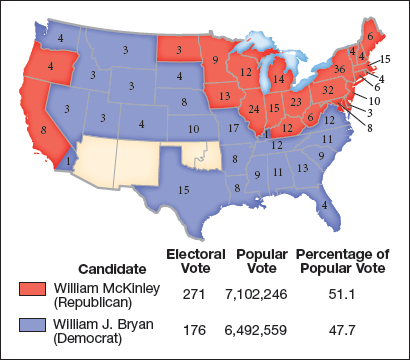Political Realignment in the Election of 1896
The presidential election of 1896 marked a turning point in the political history of the nation, one that would shape national politics for the next thirty-six years. Democrats nominated William Jennings Bryan of Nebraska, a farmers’ advocate who favored silver coinage. When he vowed that he would not see Republicans “crucify mankind on a cross of gold,” the Populists endorsed him as well. Bryan was the first major party nominee for the White House since 1868 who did not come from Ohio, Indiana, or New York.
Republicans nominated William McKinley, the governor of Ohio and a supporter of the gold standard and high tariffs on manufactured and other goods. While Bryan barnstormed around the country, McKinley remained at his home in Canton, Ohio, to conduct his campaign from his front porch. His campaign manager, Marcus Alonzo Hanna, an ally of Ohio senator John Sherman, raised an unprecedented amount of money, about $16 million, mainly from wealthy industrialists who feared that the free and unlimited coinage of silver would debase the U.S. currency. Hanna saturated the country with pamphlets, leaflets, and posters, many of them written in the native languages of immigrant groups. He also hired a platoon of speakers to fan out across the country denouncing Bryan’s free silver cause as financial madness. Republican Theodore Roosevelt, who would later become president himself, remarked that Hanna advertised McKinley “as if he were patent medicine.” By contrast, Bryan raised about $1 million and had to travel around the country making personal appearances, in part to compensate for his campaign’s lack of funds.
The outcome of the election transformed the Republicans into the majority party in the United States. McKinley won 51 percent of the popular vote and 61 percent of the electoral vote, making him the first president since Grant in 1872 to win a majority of the popular vote. More important than this specific contest, however, was that the election proved critical in realigning the two parties. Voting pat-terns shifted with the 1896 election, giving Republicans the edge in party affiliation among the electorate not only in this contest but also in presidential elections over the next three decades (Map 17.1).

What happened to produce this critical realignment in electoral power? The main ingredient was Republi-cans’ success in fashioning a coalition that included both corporate capitalists and their workers. Although Bryan made sincere appeals for the votes of urban dwellers and industrial workers along class lines, they generally fell on deaf ears. Many of these voters took out their anger on Cleveland’s Democratic Party and Bryan as its standard-bearer for failing to end the depression. In addition, Bryan, who hailed from Nebraska and reflected small-town agricultural America and its values, could not win over the swelling numbers of urban immigrants who considered Bryan’s world alien to their experience. A great orator, Bryan nevertheless sounded anti-urban, and his defeat signaled the decline of rural America in presidential politics. His campaign was the last serious effort to win the White House with mostly farm and small-town votes.
The election of 1896 broke the political stalemate in the Age of Organization. The core of Republican backing came from industrial cities of the Northeast and Midwest. Republicans won support from their traditional constituencies of Union veterans, businessmen, and African Americans and added to it the votes of a large number of urban wageworkers. The campaign persuaded voters that the Democratic Party represented the party of depression and that Republicans stood for prosperity and progress. Another factor helping the Republicans was that in 1897 the depression finally ended, largely as a result of gold discoveries in Alaska, which helped increase the money supply, and foreign crop failures, which raised American farm prices. Democrats managed to hold on to the South as their solitary political base.